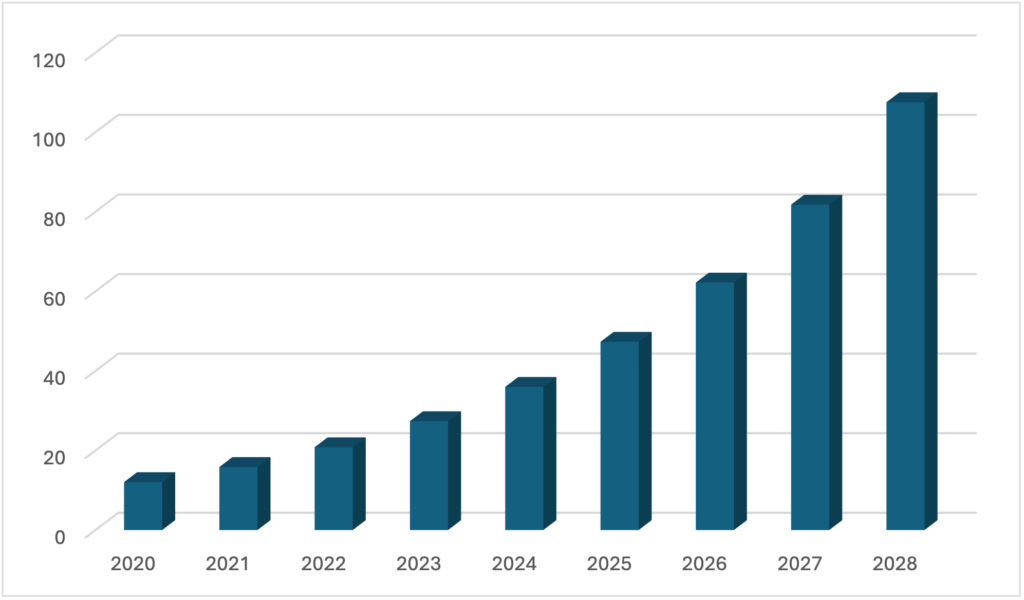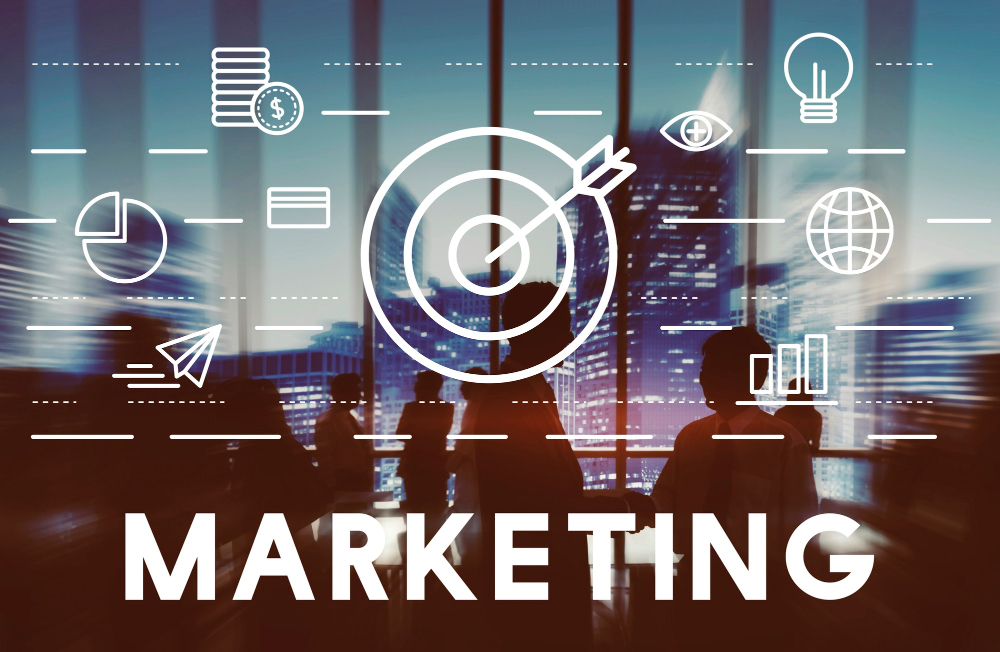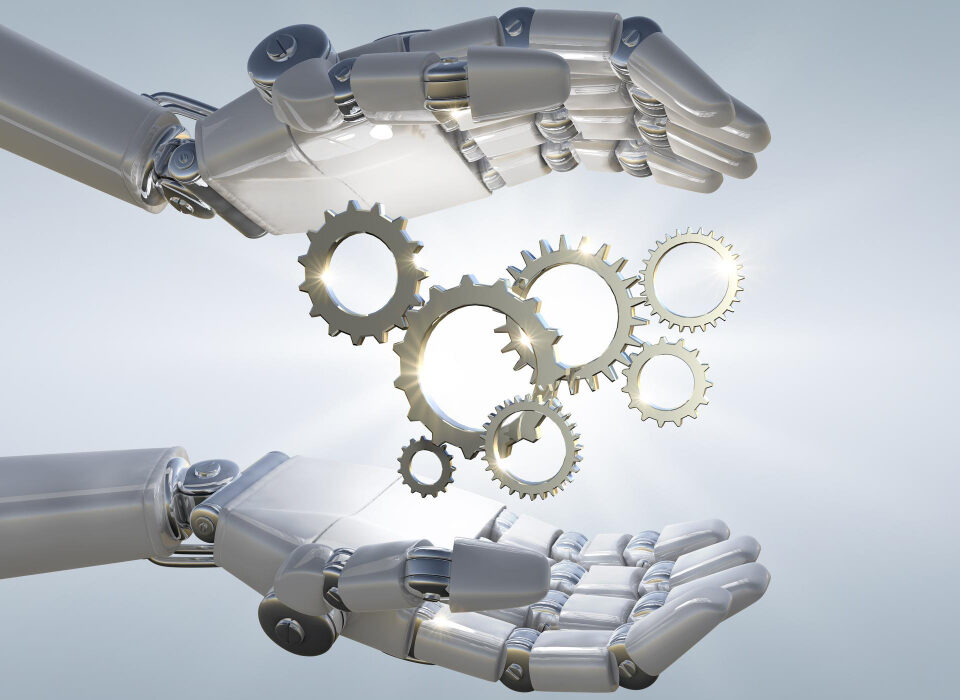- Mail:
- info@digital4pro.com
Come l’AI può intervenire nell’area marketing

IoT: Standard LPWANs Licensed Spectrum
9 Aprile 2025
OT: Gli attacchi più famosi ai sistemi industriali
16 Aprile 20251. Introduzione
L’area marketing è un’unità organizzativa che ha come obiettivi quelli di comprendere le esigenze e i bisogni della clientela, promuovere i prodotti e i servizi aziendali e indurre i clienti a fare acquisti. Negli ultimi anni, questa funzione aziendale è stata rivoluzionata dall’avvento dell’intelligenza artificiale.
Secondo una ricerca condotta da Deloitte, tre dei principali cinque motivi che hanno spinto le organizzazioni a investirein questa tecnologia sono strettamente correlati al marketing. In particolare, questi riguardano il miglioramento deiprodotti e dei servizi già esistenti, lo sviluppo di prodotti e servizi innovativi e il potenziamento del rapporto con i consumatori[1].
Questa tendenza viene confermata anche dalle previsioni di Statista, secondo cui il valore del mercato dell’intelligenza artificiale in questa unità organizzativa è destinato a crescere rapidamente, passando dai circa 12 miliardi di dollari del 2020 agli oltre 100 miliardi di dollari del 2028.

Figura 1 – Previsione sul valore del mercato dell’intelligenza artificiale nell’area marketing ( valori in miliardi di dollari) [Fonte: https://www.statista.com/statistics/1293758/ai-marketing-revenue-worldwide/ 2022/07/25].
2. Tecniche per l’implementazione dell’AI nel marketing
Esistono due principali tecniche tramite cui questa tecnologia può essere sfruttata nel marketing[2].
La prima riguarda l’automazione di compiti semplici e ripetitivi, che richiedono un livello di intelligenza relativamente basso. In questa categoria vi rientrano quei sistemi, come i chatbot, che per esempio inviano in maniera automatica una e-mail di benvenuto a un nuovo utente.
La seconda invece, si riferisce all’impiego del machine learning, il quale è in grado di analizzare grandi quantità di dati e di prendere decisioni complesse, come per esempio prevedere il modo in cui un certo cliente reagirà a unadeterminata campagna promozionale.
3. Vantaggi dell’implementazione dell’AI nel marketing
A livello complessivo, si può dire che l’uso dell’intelligenza artificiale in quest’area può incrementare i ricavi e ridurre i costi[3]. Nello specifico, le entrate sono destinate a crescere a causa della possibilità di prendere decisioni migliori,tramite per esempio il pricing dinamico, le promozioni personalizzate in tempo reale e le raccomandazioni dei prodotti. I costi invece, possono diminuire grazie all’automazione di alcuni semplici compiti di marketing, come per esempio larisposta automatica dei chatbot alle domande più frequenti provenienti dai consumatori.
| FASE DEL CUSTOMER
JOURNEY |
SUPPORTO FORNITO DALL’IA |
| Ricerca di un prodotto | Pubblicità mirate e suggerimenti in funzione delle ricerche effettuate in passato dal cliente |
| Vendita | Ottimizzazione del prezzo di vendita grazie al pricingdinamico, che modifica le offerte commerciali in funzione delle condizioni di mercato e delle caratteristiche delconsumatore
I sistemi di raccomandazione favoriscono i fenomeni dell’up- selling e del cross-selling, suggerendo prodotticomplementari Si riduce la probabilità che l’acquisto non venga portato a termine grazie a pubblicità di reindirizzamento |
| Post-vendita | Potenziamento nell’analisi delle reazioni dei clienti mediantei commenti sui social network o tramite le recensionieffettuate
Chatbot disponibili 24 ore su 24 in grado di rispondere alle domande più frequenti poste dalla clientela |
Tabella 1 – Supporto fornito dall’intelligenza artificiale nelle principali fasi del customer journey [Fonte: Nair, K., & Gupta, R. (2021), Davenport, T., Guha, A., Grewal, D., & Bressgott, T. (2020) e Zaki, M., McColl-Kennedy, R., & Neely,A. (2021)].
Di conseguenza, anche in questo reparto organizzativo le macchine intelligenti costituiscono uno strumento che può avvantaggiare le organizzazioni e rinforzare le abilità umane. Per questo motivo, le aziende sono solite impiegare l’intelligenza artificiale in tutte le fasi del “customer journey”[4], ovvero quel percorso che indica tutti i punti di contatto tra impresa e consumatore nel rapporto commerciale.
Esso comincia nella fase in cui un cliente sta cercando un particolare prodotto. A tal scopo, gli algoritmi realizzano delle pubblicità mirate e propongono dei suggerimenti, volti a semplificare la ricerca stessa. Per fare ciò, si analizzano le ricerche effettuate nel passato da quello stesso utente sul sito web dell’azienda, in maniera tale da prevedere gli articoli ai quali può essere interessato.
Si comprende quindi come l’intelligenza artificiale permetta di estrapolare dai big data un insieme di informazioni fondamentali per sviluppare efficaci strategie personalizzate di marketing. Ovviamente, ciò è stato reso possibile dalle già citate evoluzioni nella capacità di elaborazione e in quella di archiviazione dei dispositivi elettronici, che hanno consentito di immagazzinare e processare una maggiore quantità di dati sulla clientela.
A tal proposito, il machine learning, grazie all’analisi dei dati a disposizione, ottimizza il prezzo di vendita[5]. Ciòsignifica che quest’ultimo è sufficientemente basso da attrarre clienti, ma anche abbastanza alto da consentireall’azienda di ottenere una remunerazione.
Quest’operazione è conosciuta come “pricing” ed è dinamica, in quanto le offerte commerciali vengono modificate in tempo reale, in modo tale da riflettere le condizioni di mercato e da considerare alcune caratteristiche del cliente, come la sua localizzazione geografica e la sua disponibilità all’acquisto. Inoltre, è possibile effettuare delle personalizzazioni volte a fare promozioni a quell’utente che è disponibile ad acquistare soltanto in caso di sconto e a non farle a chi invece è pronto a comprare anche al prezzo standard di base. In questa maniera, è possibile aumentare il numero complessivo delle vendite e, conseguentemente, anche i profitti.
L’analisi dei dati permette anche di ampliare la conoscenza del mercato di riferimento. Nello specifico, vi è la possibilità di approfondire maggiormente le caratteristiche della clientela, esaminando non solo gli acquisti effettuati nel passato e le ricerche sul sito web aziendale, ma anche le reazioni alle promozioni commerciali e gli eventuali commenti sui socialmedia in merito ai prodotti e ai servizi dell’impresa. Successivamente, è possibile creare un profilo di ciascun singolocliente e poi, tramite gli algoritmi, si può prevedere quali saranno i loro interessi futuri.
Sulla base di queste previsioni poi, vengono raccomandati quei prodotti che si presume possano interessare a quel particolare consumatore. L’abilità predittiva rappresenta quindi una delle caratteristiche cruciali dell’intelligenza artificiale nell’area marketing.
Tale capacità è particolarmente elevata per i prodotti già esistenti, mentre è decisamente più complesso raggiungere un buon livello di accuratezza relativamente ai nuovi prodotti. Ciò è dovuto al fatto che gli algoritmi di machine learningapprendono dall’esperienza passata, ottimizzando progressivamente le loro prestazioni. Di conseguenza, sui prodotti più maturi hanno ormai raggiunto un livello di precisione elevato, mentre su quelli nuovi necessitano di un precedente periodo di raccolta dei dati prima di essere accurati.
Un altro strumento di analisi rilevante è dato dal deep learning, il quale è in grado di esaminare i dati non quantitativi, come le espressioni facciali o le parole utilizzate dal cliente, in modo tale da comprendere cosa quest’ultimo desideraeffettivamente e se è soddisfatto o meno dell’offerta proposta dall’azienda. Altro vantaggio significativo è dato dal rafforzamento dei fenomeni dell’up-selling e del cross- selling. Il primo induce il consumatore a spendere di più presso l’azienda, mentre il secondo stimola il cliente ad acquistare prodotti o servizi aggiuntivi. Questi eventi sono agevolati dai sistemi di raccomandazione, i quali, quando si acquista un certo prodotto, suggeriscono servizi o prodotti complementari che generalmente altri clienti acquisiscono contemporaneamente.
Questi sistemi imparano dall’esperienza passata, per cui ogni volta in cui un suggerimento viene accolto o rifiutato, sfruttano questa informazione per ottimizzare la loro abilità predittiva. Si riduce poi anche la probabilità che il consumatore abbandoni il proprio carrello digitale, attraverso delle chat che motivano a portare a termine l’acquisto. Oppure, se il potenziale acquirente non ha portato a termine l’ordine, si possono utilizzare delle pubblicità di reindirizzamento in cui si propone il medesimo prodotto scontato. Dopo la vendita, si impiegano degli agenti digitali disponibili a rispondere alle domande della clientela in qualunque momento del giorno, al fine di fronteggiare anche i picchi di richiesta. Infine, l’intelligenza artificiale può essere impiegata per monitorate in tempo reale lo stato d’animo e il grado di soddisfazione della clientela[6]. In particolare, gli algoritmi analizzano le parole utilizzate dai consumatori nellerecensioni per comprendere se questi sono soddisfatti, oppure se hanno riscontrato delle problematiche. Ciò viene fatto in maniera del tutto automatica, andando così a sostituire i tradizionali sondaggi di carattere quantitativo. In più, in caso di lamentele prolungate e di rischio di abbandono, l’intelligenza artificiale può intervenire e formulare delle offertepersonalizzate particolarmente vantaggiose, volte a trattenere il cliente.
4. Svantaggi dell’implementazione dell’AI nel marketing
Nonostante tutti gli aspetti positivi appena descritti, sono presenti anche delle criticità relativamente all’implementazione dell’intelligenza artificiale in quest’area organizzativa.
Queste riguardano prevalentemente la percezione dei consumatori nei confronti delle macchine intelligenti. Non tutti i clienti, infatti, accolgono positivamente la sostituzione degli addetti alle vendite con l’intelligenza artificiale, poichéquest’ultima è meno empatica rispetto agli esseri umani.
Secondo alcuni dati, quando un cliente parla con un agente intelligente piuttosto che con un addetto alle vendite umano il tasso di acquisto cala del 75%[7]. Tale problematica, come già detto nel primo capitolo, potrebbe essere eliminata grazie alla futura evoluzione delle macchine intelligenti, che, secondo alcune previsioni, le condurrà verso l’acquisizione della cosiddetta “intelligenza emotiva”.
Un altro rischio significativo riguarda la già citata necessità di garantire la privacy e la sicurezza dei consumatori, nel momento in cui le organizzazioni sfruttano i loro dati personali per fini pubblicitari. La mancata osservanza delle normative sulla privacy potrebbe coinvolgere le aziende in complesse cause legali con un probabile esito sfavorevole, per cui l’attenzione su questo aspetto dovrebbe essere massima. Inoltre, come vale per tutte le aree organizzative, l’introduzione di questa tecnologia in questo ambito richiede considerevoli investimenti tecnologici, prima che le aziende possano usufruire appieno dei benefici sopra descritti.
5. Conclusioni
In conclusione, si può affermare che attualmente, nonostante la tendenza crescente delle organizzazioni ad automatizzare sempre di più le attività legate al marketing, l’intelligenza artificiale è in grado di svolgere soltanto un insieme di compiti di questo tipo, ma non può ancora gestire in maniera completamente autonoma questa funzione.
Di conseguenza, anche in quest’area organizzativa la soluzione migliore sembra essere quella di una collaborazione tra uomo e macchina intelligente, al fine di sfruttare i rispettivi vantaggi e di eliminare le relative debolezze.
A tal proposito, l’intelligenza artificiale può focalizzarsi sullo svolgimento dei compiti ripetitivi e predittivi, al fine diconsentire ai responsabili della funzione di dedicare più tempo alle attività che richiedono creatività, immaginazione econtatto umano.
Bibliografia
- Agrawal, A., Gans, J., & Goldfarb, A. (2017). The trade-off every AI company will face.
- Harvard Business Review Digital Articles.
- Aspan, M. (2020). Siri, Did I Ace the Interview? Fortune International (Europe), 181(2).
- Bhimani, A., & Willcocks, L. (2014). Digitisation, Big Data and the transformation of accounting information. Accounting and Business Research, Taylor & Francis, Vol. 44 No. 4.
- Brundage, M., Avin, S., Clark, J., Toner, H., Eckersley, P., Garfinkel, B., … & Amodei, D. (2018). The malicious use of artificial intelligence: Forecasting, prevention, and mitigation. arXiv preprint arXiv:1802.07228.
- CGMA (2016). Business Analytics And Decision Making. Baseline.
- Costa, G., & Gianecchini, M. (2019). Risorse umane: persone, relazioni e valore (Vol. 454). McGraw-Hill.
- Craigen, D., Diakun-Thibault, N., & Purse, R. (2014). Defining cybersecurity. Technology Innovation Management Review, 4(10).
- Daft, R. L. (2017). Organizzazione aziendale. Sesta edizione. Daft, R. L. (2021). Organizzazione aziendale. Maggioli, Milano.
- Davenport, T., Guha, A., & Grewal, D. (2021). How to Design an AI Marketing Strategy: What the Technology Can Do Today—and What’s Next. Harvard Business Review, 99, 42- 47.
- Davenport, T., Guha, A., Grewal, D., & Bressgott, T. (2020). How artificial intelligence will change the future of marketing. Journal of the Academy of Marketing Science, 48(1), 24- 42.
- Doke, D. (2021). Software AI. Recruiter.
- Forger, G. (2020). AI and IoT are ready for your warehouse. Logistics management (Highlands Ranch, Colo.: 2002).
- Fountaine, T., McCarthy, B., & Saleh, T. (2021). Getting AI to scale. Harvard Business Review.
- Galeotti, M., & Garzella, S. (Eds.). (2013). Governo strategico dell’azienda: Prefazione del Prof. Umberto Bertini. G Giappichelli Editore.
- Gambhir, B., & Bhattacharjee, A. (2021). Embracing the role of artificial intelligence in accounting and finance: contemplating the changing skillset expectations. Development and Learning in Organizations: An International Journal.
- Gregg, M. (2005). CISSP security-management practices. Upper Saddle River, NJ: Pearson Education.
- Haenlein, M., & Kaplan, A. (2019). A brief history of artificial intelligence: On the past, present, and future of artificial intelligence. California management review, 61(4), 5-14.
- Harrison, N., & O’Neill, D. (2017). If your company isn’t good at analytics, it’s not ready for AI. Harvard Business Review.
- Henke, N., Levine, J., & McInerney, P. (2018). You don’t have to be a data scientist to fill this must-have analytics role. Harvard Business Review.
- Huang, M. H., Rust, R., & Maksimovic, V. (2019). The feeling economy: Managing in the next generation of artificial intelligence (AI). California Management Review, 61(4), 43-65.
- Lichtenthaler, U. (2020). Mixing data analytics with intuition: Liverpool Football Club scores with integrated intelligence. Journal of Business Strategy.
- Luo, X., Qin, M. S., Fang, Z., & Qu, Z. (2021). Artificial intelligence coaches for sales agents: Caveats and solutions. Journal of Marketing, 85(2), 14-32.
- McAfee, A., & Brynjolfsson, E. (2012). Big data: the management revolution. Harvard business review, 90(10), 60-68.
- Miyashita, M., & Brady, M. (2019). The Health Care Benefits of Combining Wearables and AI. Harvard Business Review.
- Nair, K., & Gupta, R. (2021). Application of AI technology in modern digital marketing environment. World Journal of Entrepreneurship, Management and Sustainable Development.
- Niehueser, W., & Boak, G. (2020). Introducing artificial intelligence into a human resources function. Industrial and commercial training, 52(2), 121-130.
- Ore, O., & Sposato, M. (2021). Opportunities and risks of artificial intelligence in recruitment and selection. International Journal of Organizational Analysis.
- Paschen, J., Kietzmann, J., & Kietzmann, T. C. (2019). Artificial intelligence (AI) and its implications for market knowledge in B2B marketing. Journal of Business & Industrial Marketing.
- Paschen, U., Pitt, C., & Kietzmann, J. (2020). Artificial intelligence: Building blocks and an innovation typology. Business Horizons, 63(2), 147-155.
- Petkov, R. (2020). Artificial intelligence (AI) and the accounting function—A revisit and a new perspective for developing framework. Journal of emerging technologies in accounting, 17(1), 99-105.
- Pighin, M., & Marzona, A. (2018). Sistemi informativi aziendali: ERP e sistemi di data analysis.
- Poba-Nzaou, P., Galani, M., Uwizeyemungu, S., & Ceric, A. (2021). The impacts of artificial intelligence (AI) on jobs: an industry perspective. Strategic HR Review, 20(2), 60- 65.
- Ponnapalli, P. (2022). Keys to successful innovation through artificial intelligence. Harvard Business Review.
- Ransbotham, S., Candelon, F., Kiron, D., LaFountain, B., & Khodabandeh, S. (2021). The Cultural Benefits of Artificial Intelligence in the Enterprise. MIT Sloan Management Review and Boston Consulting Group.
- Rudko, I., Bashirpour Bonab, A., & Bellini, F. (2021). Organizational structure and artificial intelligence. Modeling the intraorganizational response to the ai contingency. Journal of Theoretical and Applied Electronic Commerce Research, 16(6), 2341-2364.
- Samonas, S., & Coss, D. (2014). The CIA strikes back: Redefining confidentiality, integrity and availability in security. Journal of Information System Security, 10(3).
- Shrestha, Y. R., Ben-Menahem, S. M., & Von Krogh, G. (2019). Organizational decision- making structures in the age of artificial intelligence. California Management
- Review, 61(4), 66-83.
- Simonovich, L. (2021). Balancing AI advances with robust cybersecurity solutions. World Oil.
- Soni, V. D. (2020). Challenges and Solution for Artificial Intelligence in Cybersecurity of the USA. Available at SSRN 3624487.
- Strubell, E., Ganesh, A., & McCallum, A. (2019). Energy and policy considerations for deep learning in NLP. arXiv preprint arXiv:1906.02243.
- Tabesh, P. (2021). Who’s making the decisions? How managers can harness artificial intelligence and remain in charge. Journal of Business Strategy.
- S (2021). 3 areas where AI will boost your competitive advantage. Harvard Business Review Digital Articles.
- Truong, T. C., Zelinka, I., Plucar, J., Čandík, M., & Šulc, V. (2020). Artificial intelligence and cybersecurity: Past, presence, and future. In Artificial intelligence and evolutionary computations in engineering systems (pp. 351-363). Springer, Singapore.
- Tschang, F. T., & Almirall, E. (2021). Artificial intelligence as augmenting automation: Implications for employment. Academy of Management Perspectives, 35(4), 642-659.
- Tse, T., Esposito, M., Takaaki, M., & Goh, D. (2020). The dumb reason your AI project will fail. Harvard business review digital articles, 2-5.
- Vadari, S., & Desik, P. A. (2021). The Role of AI/ML in Enhancing Knowledge Management Systems. IUP Journal of Knowledge Management, 19(2), 7-31.
- Wamba-Taguimdje, S. L., Wamba, S. F., Kamdjoug, J. R. K., & Wanko, C. E. T. (2020). Influence of artificial intelligence (AI) on firm performance: the business value of AI-based transformation projects. Business Process Management Journal, 26(7), 1893-1924.
- Whitmore, A., Agarwal, A., & Da Xu, L. (2015). The Internet of Things—A survey of topics and trends. Information systems frontiers, 17(2), 261-274.
- Yampolskiy, R. V. (2017). AI Is the Future of Cybersecurity, for Better and for Worse. Harvard Business Review. May, 8.
- Zaki, M., McColl-Kennedy, R., & Neely, A. (2021). Using AI to Track How Customers Feel—In Real Time. Harvard Business Review.
- Zhang, H., Zhang, X., & Song, M. (2021). Deploying AI for New Product Development Success: By embracing and incorporating AI in all stages of NPD, companies can increase their success rate of NPD projects. Research-Technology Management, 64(5), 50-57.
- Zouave, E., Gustafsson, T., Bruce, M., Colde, K., Jaitner, M., & Rodhe, I. (2020). Artificially intelligent cyberattacks. Swedish Defence Research Agency, FOI, Tech. Rep. FOI.
- (2017). Lavazza a caccia di “coffe addicted” con l’intelligenza artificiale. Il Sole 24 Ore. Retrieved fromhttps://www.ilsole24ore.com/art/lavazza-caccia-coffee-addicted-l- intelligenza-artificiale–AEBRpxQD 2022/08/02
- Amar, J., Majumder, S., Surak, Z., & von Bismarck, N. (2021). How AI-driven nudges can transform an operation’s performance. McKinsey Global Institute. Retrieved from https://www.mckinsey.com/business-functions/operations/our-insights/how-ai-driven- nudges-can-transform-an-operations-performance 2022/07/27
- Balabio, B., Orlando, P., & Scolari, T. (2021). Cresce il mercato dell’intelligenza artificiale in Italia. Retrieved from https://www.osservatori.net/it/ricerche/comunicati- stampa/artificial-intelligence-italia-mercato-progetti-20202022/07/08
- Berruti, F., Nel, P., & Whiteman R. (2020). An executive primer on artificial general intelligence. McKinsey Global Institute. Retrieved from https://www.mckinsey.com/business-functions/operations/our-insights/an-executive- primer-on-artificial-general-intelligence 2022/07/06
- Boehm, J., Curcio, N., Merrath, P., Shenton, L., & Stahle T. (2019). The risk-based approach to cybersecurity. McKinsey Global Institute. Retrieved from https://www.mckinsey.com/business-functions/risk-and-resilience/our-insights/the-risk- based-approach-to-cybersecurity 2022/08/03
- Brooks, C. (2022). Alarming cyber statistics for mid-year 2022 that you need to know. Forbes. Retrieved from https://www.forbes.com/sites/chuckbrooks/2022/06/03/alarming- cyber-statistics-for-mid-year-2022-that-you-need-to-know/?sh=7043d0247864 2022/08/03
- Brown, S., Gandhi, D., Herring, L., & Puri, A. (2019). The analytics academy: bridging the gap between human and artificial intelligence. McKinsey Global Institute. Retrieved from https://www.mckinsey.com/business-functions/mckinsey-analytics/our-insights/the- analytics-academy-bridging-the-gap-between-human-and-artificial-intelligence 2022/07/18
- Buehler, K., Dooley, R., Grennan, L., & Singla, A. (2021). Getting to know-and manage- your biggest AI risks. McKinsey Global Institute. Retrieved from https://www.mckinsey.com/business-functions/mckinsey-analytics/our-insights/getting-to- know-and-manage-your-biggest-ai-risks 2022/07/11
- Bughin, J., Seong, J., Manyika, J., Chui, M., & Joshi, R. (2018). Notes from the AI frontier: Modeling the impact of AI on the world economy. McKinsey Global Institute. Retrieved from https://www.mckinsey.com/featured-insights/artificial-intelligence/notes-from-the-ai- frontier-modeling-the-impact-of-ai-on-the-world-economy#part1 2022/07/15
- Chakraborty, A. (2021). A.I. can be a cornerstone of success – but only if leaders make the right choices. Fortune. Retrieved from https://fortune.com/2021/10/27/ai-artificial- intelligence-business-strategy-data-accenture/ 2022/07/29
- Chui, M., Hall, B., Singla, A., & Sukharevsky, A. (2021). The state of AI in 2021. McKinsey Global Institute. Retrieved from https://www.mckinsey.com/business- functions/quantumblack/our-insights/global-survey-the-state-of-ai-in-20212022/07/08
- Chui, M., Manyika, J., Miremadi, M., Henke, N., Chung, R., Nel, P., & Malhotra, S. (2018). Notes from the AI frontier: Applications and value of deep learning. McKinsey global institute discussion paper, April. Retrieved from https://www.mckinsey.com/featured- insights/artificial-intelligence/notes-from-the-ai-frontier-applications-and-value-of-deep- learning 2022/07/07
- Dandona, G. S., Sharma, J., & Wright, M. (2021). Our own digital journey: upskilling hundreds of McKinsey technologists in AI. McKinsey Global Institute. Retrieved from https://www.mckinsey.com/about-us/new-at-mckinsey-blog/ai-upskilling-for-over-500- firm-technologists 2022/07/19
- Fowler, G. (2020). AI and its potential for cybersecurity. Forbes. Retrieved from https://www.forbes.com/sites/forbesbusinessdevelopmentcouncil/2020/12/18/ai-and-its- potential-for-cybersecurity/?sh=5d2f609e69d9 2022/08/03
- https://assets.siemens-energy.com/siemens/assets/api/uuid:cf20f2e1-ca9c-4589-9f88- 4e6592b4672d/brochure-deeparmour-industrial-200609.pdf 2022/08/05
- https://bids.berkeley.edu/news/berkeley-institute-data-science-and-accenture-applied- intelligence-announce-new-collaboration 2022/07/18
- https://info.algorithmia.com/hubfs/2020/Reports/2021-Trends-in- ML/Algorithmia_2021_enterprise_ML_trends.pdf?hsLang=en-us 2022/07/08
- https://wwd.com/business-news/technology/levis-ai-bootcamp-data-science-1234881378/ 22/09/04
- https://www.accenture.com/_acnmedia/PDF-63/Accenture-CoBE-Brochure-
- pdf#zoom=50 2022/08/23
- https://www.accenture.com/fr-fr/_acnmedia/36dc7f76eab444cab6a7f44017cc3997.pdf 2022/07/08
- https://www.bcg.com/publications/2020/is-your-company-embracing-full-potential-of- artificial-intelligence 2022/09/17
- https://www.capgemini.com/wp-content/uploads/2019/07/AI-in- pdf 2022/08/03
- https://www.careers.ox.ac.uk/article/the-pymetrics-games-overview-and-practice- guidelines 2022/07/26
- https://www.cnr.it/sites/default/files/public/media/attivita/editoria/VOLUME%20FULL%20 14%20digital%20LIGHT.pdf 2022/08/22
- https://www.levistrauss.com/2021/05/17/machine-learning-bootcamp/ 2022/07/19
- https://www.linkedin.com/pulse/how-coca-cola-using-ai-stay-top-soft-drinks-market- shivani-salunkhe 2022/08/23
- https://www.mckinsey.com/about-us/new-at-mckinsey-blog/mckinsey-receives-top- ranking-in-the-forrester-wave-ai-report 2022/07/19
- https://www.nist.gov/system/files/documents/cyberframework/cybersecurity-framework- pdf 2022/08/03
- https://www.statista.com/statistics/1083482/worldwide-ai-revenue-increase/ 2022/08/02 https://www.statista.com/statistics/1083516/worldwide-ai-cost-decrease/ 2022/08/02
- https://www.statista.com/statistics/1119824/global-business-and-hr-leaders-on-ai-impact- to-job-numbers/ 2022/07/20
- https://www.statista.com/statistics/1235395/worldwide-ai-enabled-cyberattacks- companies/ 2022/08/05
- https://www.statista.com/statistics/1293758/ai-marketing-revenue-worldwide/ 2022/07/25
- https://www.statista.com/statistics/472934/business-analytics-software-revenue- worldwide/ 2022/07/29
- https://www.statista.com/statistics/871513/worldwide-data-created/ 2022/07/29
- https://www.statista.com/statistics/941137/ai-investment-and-funding-worldwide/ 2022/07/08
- https://www.treccani.it/enciclopedia/intelligenza-artificiale 2022/07/04
- https://www.treccani.it/enciclopedia/sicurezza-informatica/#:~:text=sicur%C3%A9zza%20inform%C3%A0tica%20Ramo%20dell’informatica,dati%20riservati%20in%20essi%20contenuti. 2022/09/13
- https://www.tripwire.com/state-of-security/security-data-protection/43-billion-stolen- through-business-email-compromise-since-2016-reports-fbi/ 2022/09/13
- https://www.webfx.com/martech/pricing/ai/#:~:text=In%202020%2C%20companies%20can%20pay,house%20or%20freelance%20data%20scientists.&text=In%20comparison
- %2C%20custom%20AI%20solutions,from%20%246000%20to%20over%20%24300%2C 000. 2022/09/18
- Jeans, D. (2020). Companies will spend $50 billion on artificial intelligence this year with little to show for it. Forbes. Retrieved from https://www.forbes.com/sites/davidjeans/2020/10/20/bcg-mit-report-shows-companies- will-spend-50-billion-on-artificial-intelligence-with-few-results/?sh=7efe3fe57c87 2022/09/17
- Johar, P. (2020). How AI makes big data smarter. Forbes. Retrieved from https://www.forbes.com/sites/forbestechcouncil/2020/03/23/how-ai-makes-big-data- smarter/?sh=381f9b6a4684 2022/08/01
- Luchtenberg, D., & Migliorini, R. (2022). Coca-Cola: The people-first story of a digital transformation. McKinsey Global Institute. Retrieved from https://www.mckinsey.com/business-functions/operations/our-insights/coca-cola-the-people-first-story-of-a-digital-transformation 2022/08/02
- Malins, A. (2022). Machine learning and artificial intelligence: implementation in practice. Forbes. Retrieved from https://www.forbes.com/sites/forbestechcouncil/2022/01/25/machine-learning-and- artificial-intelligence-implementation-in-practice/?sh=7692b2a35c89 2022/07/15
- Manyika J., & Sneader K. (2018). AI, automation, and the future of work: Ten things to solve for. McKinsey Global Institute. Retrieved from https://www.mckinsey.com/featured- insights/future-of-work/ai-automation-and-the-future-of-work-ten-things-to-solve-for 2022/07/15
- Marr, B. (2017). The Amazing Ways Coca Cola Uses Artificial Intelligence And Big Data To Drive Success. Forbes. Retrieved from https://www.forbes.com/sites/bernardmarr/2017/09/18/the-amazing-ways-coca-cola- uses-artificial-intelligence-ai-and-big-data-to-drive-success/?sh=1448c01778d2 2022/08/02
- Marr, B. (2018). The amazing ways how Unilever uses artificial intelligence to recruit & train thousands of employees. Forbes. Retrieved from https://www.forbes.com/sites/bernardmarr/2018/12/14/the-amazing-ways-how-unilever-uses-artificial-intelligence-to-recruit-train-thousands-of-employees/?sh=485a1ca76274 2022/07/26
- Marr, B. (2022). The most in – demand technical skills – and how to develop them. Forbes. Retrieved from https://www.forbes.com/sites/bernardmarr/2022/08/03/the-most- in-demand-technical-skills–and-how-to-develop-them/?sh=7a1c4e1362e4 2022/08/22
- Mohan S. (2022). How to make it easier to implement AI in your business. Forbes. Retrieved from https://www.forbes.com/sites/forbestechcouncil/2022/05/27/how-to- make-it-easier-to-implement-ai-in-your-business/?sh=481bfbd65300 2022/07/12
- Rossitto, S. (2021). “Senza intelligenza artificiale e big data impossibile un vaccino contro il Covid in tempi brevi”. Il Sole 24 Ore. Retrieved from https://www.ilsole24ore.com/art/senza-intelligenza-artificiale-e-big-data-impossibile-vaccino-contro-covid-tempi-brevi-AD5lOYHB 2022/08/01
- Rusconi, G. (2022). L’intelligenza artificiale facilita il cambiamento organizzativo. Il Sole 24 Ore. Retrieved from https://www.ilsole24ore.com/art/l-intelligenza-artificiale-facilita- cambiamento-organizzativo-AEitC2OB 2022/07/14
- Sinur, J., & Peters, E. (2019). AI & big data; better together. Forbes. Retrieved from https://www.forbes.com/sites/cognitiveworld/2019/09/30/ai-big-data-better- together/?sh=61a9e9a360b3 2022/08/01
- Taulli, T. (2021). Artificial intelligence: should you teach it to your employees? Forbes. Retrieved from https://www.forbes.com/sites/tomtaulli/2021/09/10/ai-artificial- intelligence-should-you-teach-it-to-your-employees/?sh=2bab6b507b73 2022/07/18
- Tremolada, L. (2019). Machine learning, deep learning e reti neurali. Ecco di cosa parliamo. Il sole 24 ore. Retrieved from https://www.ilsole24ore.com/art/machine- learning-deep-learning-e-reti-neurali-ecco-cosa-parliamo–AEaToEBH2022/07/07
- ASIMOV, I. (1950), I, Robot. (Cited at page 5)
- BABBAGE, C. (1982), «On the Mathematical Powers of the Calculating Engine», The Origins of Digital Computers. Texts and Monographs in Computer Science.
- BODEN, M. A. (2018), Artificial Intelligence: A Very Short Introduction.
- CAMPBELL, M., HOANE, A. J. e HSIUNG HSU, F. (2002), «Deep Blue», Artificial Intelligence, vol. 134, p. 57–83.
- CLARKE, A. C. e KUBRICK, S. (1968), 2001: A Space Odyssey.
- DICK, P. K. (1968), Do Androids Dream of Electric Sheep?
- HASHEMIPOUR, S. e ALI, M. (2020), «Amazon Web Services (AWS) – An Overview of the On-Demand Cloud Computing Platform».
- KRIZHEVSKY, A., SUTSKEVER, I. e HINTON, G. E. (2012), «ImageNet classification with deep convolutional neural networks», Communications of the ACM, vol. 60, p. 84 – 90.
- LECUN, Y., BENGIO, Y. e HINTON, G. E. (2015), «Deep Learning», Nature, vol. 521, p. 436–444.
- MASLEJ, N., FATTORINI, L., BRYNJOLFSSON, E., ETCHEMENDY, J., LIGETT, K., LYONS, T., MANYIKA, J., NGO, H., NIEBLES, J. C., PARLI, V., SHOHAM, Y., WALD, R., CLARK, J., e PERRAULT, R. (2023), «The AI Index 2023 Annual Report», Rap. tecn., AI Index Steering Committee, Institute for Human-Centered AI, Stanford University, Stanford, CA.
- MCCARTHY, J. (1960), «Programs with common sense».
- MCCARTHY, J., MINSKY, M., ROCHESTER, N. e SHANNON, C. E. (2006), «A Proposal for the Dartmouth Summer Research Project on Artificial Intelligence, August 31, 1955», AI Mag., vol. 27, p. 12–14.
- RAO, A. S. e VERWEIJ, G. (2017), «Sizing the prize: what’s the real value of AI for your business and how can you capitalise?».
- RUSSELL, B. e WHITEHEAD, A. N. (1956), «Principia Mathematica to *56».
- RUSSELL, S. e NORVIG, P. (1995), «Artificial intelligence – a modern approach: the intelligent agent book».
- TURING, A. (1937), «On computable numbers, with an application to the Entscheidungsproblem», Proc. London Math. Soc.
- VASWANI, A., SHAZEER, N. M., PARMAR, N., USZKOREIT, J., JONES, L., GOMEZ, A. N., KAISER, L. e POLOSUKHIN, I. (2017), «Attention is All you Need», in «NIPS».
Note
[1] Davenport, T., Guha, A., & Grewal, D. (2021). How to Design an AI Marketing Strategy: What the Technology Can Do Today—andWhat’s Next. Harvard Business Review, 99, 42.
[2] Davenport, T., Guha, A., & Grewal, D. (2021), op. cit., 44.
[3] Davenport, T., Guha, A., Grewal, D., & Bressgott, T. (2020). How artificial intelligence will change the future ofmarketing. Journal of the Academy of Marketing Science, 48(1), 27.
[4] Nair, K., & Gupta, R. (2021). Application of AI technology in modern digital marketing environment.
World Journal of Entrepreneurship, Management and Sustainable Development, 319.
[5] Davenport, T., Guha, A., Grewal, D., & Bressgott, T. (2020), op. cit., 32.
[6] Zaki, M., McColl-Kennedy, R., & Neely, A. (2021). Using AI to Track How Customers Feel—In Real Time.
Harvard Business Review, 4.
[7] Davenport, T., Guha, A., Grewal, D., & Bressgott, T. (2020), op. cit., 28.




